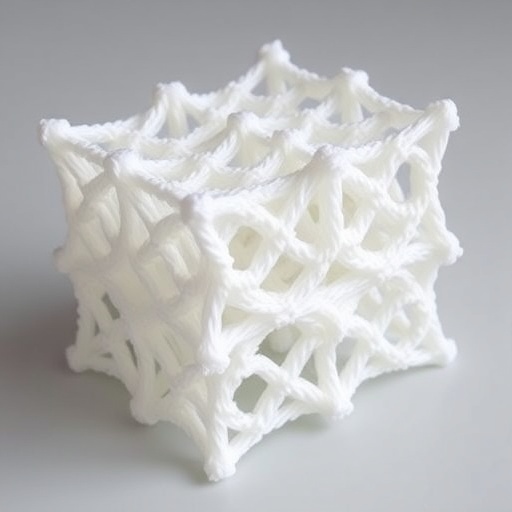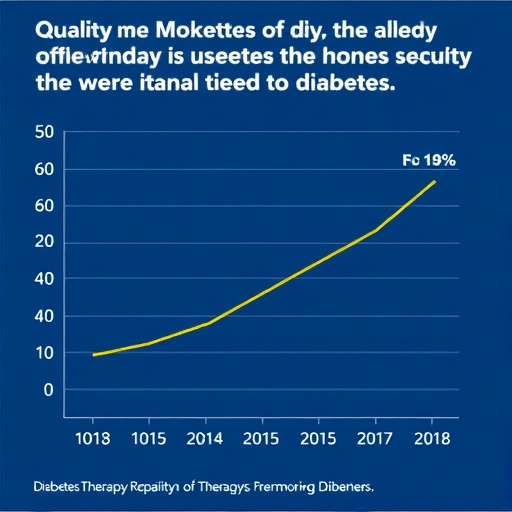PROTECT YOUR DNA WITH QUANTUM TECHNOLOGY
Orgo-Life the new way to the future Advertising by Adpathway
In recent years, the field of additive manufacturing has witnessed rapid advancements that are transforming how materials are designed and fabricated. One of the most groundbreaking developments emerging from this wave of innovation is the creation of nanofibrous ceramics via novel additive manufacturing techniques. A recent study published in npj Advanced Manufacturing introduces a cutting-edge approach that leverages the self-assembly of preceramic polymers combined with block copolymer feedstocks, providing an unprecedented pathway to fabricate nanoscale ceramic fibers with remarkable precision and functionality.
The traditional challenges of manufacturing ceramics—often brittle, difficult to shape, and limited by high-temperature processing—have long constrained their use in many advanced applications. Ceramics are prized for their thermal stability, mechanical strength, and chemical inertness, but their fabrication has typically involved sintering powders into bulk forms or coating substrates, rather than producing intricate fiber architectures. The breakthrough reported by Bowen, Clarkson, Detwiler, and colleagues illustrates how additive manufacturing can overcome these limitations by integrating molecular self-assembly with polymer chemistry.
At the heart of this innovation lies the use of preceramic polymers that can be selectively structured at the nanoscale before undergoing thermal treatment to yield ceramic materials. By incorporating block copolymers—molecules composed of two or more chemically distinct polymer segments—the researchers harnessed the polymers’ intrinsic ability to spontaneously arrange into well-defined nanostructures. This complex interplay between chemistry and physics enables the formation of fibrous networks with diameters on the order of tens of nanometers, a scale previously unattainable with conventional manufacturing methods.
The process begins with the preparation of feedstocks composed of a carefully designed blend of preceramic polymers and block copolymers. When processed through additive manufacturing platforms such as 3D printing, these feedstocks exhibit self-assembly behaviors that direct the formation of ordered nanofibers as the material is deposited. This dual functionality—printing complex macroscale shapes while simultaneously controlling nanoscale morphology—is a remarkable leap forward, enabling the direct production of ceramic structures that merge microscopic precision with macroscopic complexity.
Furthermore, the thermal conversion of these polymeric precursors into ceramics involves controlled pyrolysis, during which organic components are transformed into robust ceramic matrices. Remarkably, the team demonstrated how pre-designed nanoscale arrangements are retained through this conversion, yielding pure ceramic fibers with high surface areas and tailored mechanical properties. Such materials have enormous potential across industries where lightweight, heat-resistant, and chemically stable components are critical.
Applications for nanofibrous ceramics produced by this technique stretch across aerospace, electronics, energy storage, and biomedical fields. For example, the high surface area and structural integrity of these fibers make them ideal candidates for filters and catalytic supports, where maximizing reactive sites is paramount. Moreover, the ability to print complex geometries could revolutionize the design of structural components that require precise tuning of porosity and mechanical strength.
This intersection of polymer chemistry, materials science, and additive manufacturing elevates the concept of “materials by design” to a new frontier. The work goes beyond conventional fabrication by exploiting molecular self-assembly not merely as a laboratory curiosity but as a productive tool compatible with large-scale manufacturing protocols. This harmony between bottom-up and top-down fabrication methodologies could well be the missing link toward scalable production of advanced functional ceramics.
The published images reveal sophisticated nanoscale fiber networks that defy classical fabrication assumptions. These networks maintain structural uniformity and continuity even after significant thermal treatment—emphasizing the robustness of the embedded self-assembly mechanisms. Such consistency is crucial when considering real-world applications where materials face operational stresses, high temperatures, and harsh chemical environments.
Beyond pure scientific merit, the implications of this research ripple through sustainability and efficiency perspectives. Conventional ceramic manufacturing often involves energy-intensive processes with considerable waste. By enabling additive manufacturing of nanofibrous ceramics with a feedstock that self-organizes, the researchers have laid groundwork for cutting wastage and energy consumption, aligning future production with environmental constraints.
The seamless integration of block copolymers tailored for controlled self-assembly underscores the importance of designing multifunctional polymers not only for their chemical structure but for their manufacturing compatibility. This approach epitomizes the modern trend of combining molecular-level control with advanced fabrication technologies—melding chemistry, physics, and engineering into a cohesive platform.
Critical to the success of this method is the precise tuning of polymer composition, molecular weight, and processing conditions. Such parameters influence the self-assembly dynamics, filament formation, and final ceramic morphology. This controllability allows a choreography of materials science where one can potentially program properties such as fiber diameter, orientation, porosity, and mechanical stiffness—a material scientist’s dream realized.
Moreover, the team’s approach addresses scale-up challenges commonly encountered when translating nanomaterials from laboratory prototypes to industrial-scale production. By implementing feedstocks compatible with contemporary additive manufacturing machines, their process offers a near-term avenue for commercialization, thereby accelerating the timeline from fundamental discovery to practical application.
In the context of emerging technologies, nanofibrous ceramics fabricated by this self-assembling polymer feedstock strategy could play a vital role in next-generation electronics where thermal management and dielectric properties are crucial. Similarly, biomedical devices demanding biocompatibility and structural complexity could benefit immensely from these intricate ceramic architectures.
To further contextualize, this advance can be contrasted against other methods for ceramic fiber fabrication, such as electrospinning or chemical vapor deposition, which often struggle with scale, uniformity, or throughput. The additive manufacturing route combined with self-assembly addresses these issues holistically, delivering a scalable pathway without sacrificing nanoscale control.
Looking ahead, researchers envision expanded portfolios of preceramic polymers and block copolymer combinations tailored for a spectrum of ceramic compositions—oxides, carbides, nitrides—each offering unique properties for targeted applications. This modularity could foster rapid prototyping and customization unmatched by traditional ceramic manufacturing.
Ultimately, this pioneering work illustrates the power of convergent technologies and interdisciplinary research efforts in shaping the future of materials science. By merging molecular self-assembly with additive manufacturing, the study heralds a new era where ceramics can be engineered and fabricated with a previously unattainable level of design freedom, precision, and functionality.
As industry and academia continue to push the boundaries of what is possible, innovations like this serve as vital milestones, inspiring new directions in sustainable, high-performance materials engineering. The potential for nanofibrous ceramics to revolutionize sectors from aerospace to medicine is immense, and this latest breakthrough may well be the catalyst that transforms visionary concepts into everyday realities.
Subject of Research: Nanofibrous ceramics fabricated via additive manufacturing using self-assembling preceramic polymer and block copolymer feedstocks.
Article Title: Nanofibrous ceramics via the additive manufacturing of self-assembling preceramic polymer and block copolymer feedstocks.
Article References:
Bowen, J.J., Clarkson, C.M., Detwiler, K.N. et al. Nanofibrous ceramics via the additive manufacturing of self-assembling preceramic polymer and block copolymer feedstocks. npj Adv. Manuf. 2, 39 (2025). https://doi.org/10.1038/s44334-025-00047-8
Image Credits: AI Generated
Tags: 3D printed nanofibrous ceramicsadditive manufacturing advancementsapplications of nanofibrous ceramicsblock copolymer feedstockschallenges in ceramic fabricationinnovations in ceramic materialsmechanical properties of ceramicsmolecular self-assembly techniquesnanoscale ceramic fiberspreceramic polymer technologiesself-assembling polymers in manufacturingthermal treatment of polymers


 4 hours ago
1
4 hours ago
1





















 English (US) ·
English (US) ·  French (CA) ·
French (CA) ·